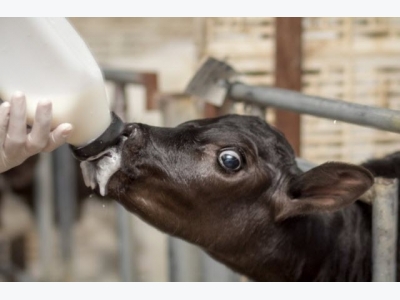US researchers use prebiotics, probiotics and milk intake to improve calf health

Dairy calves may see long-term benefits from use of prebiotics or probiotics and additional milk replacer intake, say scientists based at Texas Tech University.
They have been studying the lifelong effects of improved early nutrition for dairy calves.
Michael Ballou, professor of ruminant nutrition and immunology, at Texas Tech told FeedNavigator, “We know that early-life experiences can have long-term impacts and that’s my interest now – early life nutrition’s influence on long term cattle health,” he said.
Early research and results
Calves are susceptible to gastrointestinal disease in the pre-weaning period.
The Dairy Heifer Raiser report from the US Department of Agriculture (USDA) showed mortality for heifer calves before they are weaned was about 4.2% in 2010.
Some of Ballou’s research into early life nutrition looks at addressing the prevention of scouring or septicemia in calves and one such study examined the effect feeding more milk or milk replacement and prebiotics, probiotics and protein from hyper-immunized eggs additives could have on calf health.
In the study, 45 non-weaned calves were given an additive treatment containing Lactobacillus acidophilus, Bacillus subtilis, Bifidobacterium thermophilum, Enterococcus faecium, Bifidobacterium longum, 2 grams of MOS, FOS, charcoal and 3.2 grams of dried egg protein from hens vaccinated against K99+ Escherichia coli antigen, Salmonella typhimurium, Salmonella Dublin, coronavirus and rotavirus.
A control group of 40 calves did not receive the supplement. But, both groups were fed two quarts of 20% protein and 20% fat non-medicated milk replacer twice a day.
Fecal scores ranging from firm to liquid were kept for all the calves. The calves getting the treatment refused less milk during the first four days and had decreased incidence of scours during the first 21 days with 25% to 51.1%.
Some of the research Ballou has carried out focused on calves’ ability to repel diseases months after they are weaned.
In several separate studies, he examined the response to disease challenges in calves that received a higher plane of nutrition through increased amounts of milk or milk replacer.
One study used blood taken from Jersey bull calves that were fed a larger amount of fluid nutrition and reported that they had better neutrophil and whole blood E.coli killing abilities even after they were weaned in comparison to Jersey calves fed a more traditional and lower plane of nutrition.
Two other, follow-up trials involved health challenges to weaned calves, one used salmonella and another respiratory infection, said Ballou. In both trials, the calves that had again received a higher plane of nutrition had less inflammation after the disease was introduced.
Nutrition costs
It is more expensive in the short term to feed more milk replacer, said Ballou. However, those costs should be offset by better long-term health, improvement in performance and the possibility of having a heifer calve earlier.
Calves fed better nutrition before they’re weaned may produce higher amounts of milk on their first lactation, he said.
“At the end of the day, if you feed more milk and milk replacer, it’s more expensive than calf starter and it’s going to cost a little more,” he said. “But if they calve a month earlier (and) if you look at the cost of raising (the calf) to having its first calf, it’s not going to be much different.”
Possible downsides
There have been some concerns about feeding higher levels of nutrition, said Ballou. These often include that calf manure looks looser and that calves would not digest the increased nutrition.
One experiment he ran examined the moisture content in calf fecal material, he said. The amount of moisture present was the same as that of other calves. He added that while the manure may look looser, it’s more a matter of perception than actuality.
Additionally, in a digestibility study, his group found that healthy calves were able to absorb higher levels of nutrition. However, that work hasn’t been done with higher risk calves.
“We collected and measured everything going in and everything going out and calves fed higher levels of nutrition have higher levels of protein digestibility,” said Ballou. “They were able to digest and absorb the higher levels of nutrients.”
Next steps
In the future, Ballou said he is planning to study the disease prevention effects of increased calf nutrition on a larger scale and with naturally occurring diseases, instead of the specific challenge tests he has already researched.
At this point, he said, he needs to see “spontaneous reaction” to disease before making final conclusions.
He said he also is planning a second test to confirm the results gained during a probiotic trial looking at calf performance. In the initial run of the experiment, calves that received a probiotic supplement gained 12-20 pounds, but more work is needed to verify that finding.
“Calves for a long time have been neglected, and I want to identify cost effective strategies to raise healthy calves that will be healthy cows,” he said.
Related news
 Cutting silage? Here’s how to make the neighbours jealous with your quality silage
Cutting silage? Here’s how to make the neighbours jealous with your quality silage The silage season has kicked into gear with farmers taking advantage of the good weather to make the coming winter’s feed.
 Method converts dairy waste water to animal feed, fuel
Method converts dairy waste water to animal feed, fuel A University of Tübingen biotechnologist seeks to recycle waste with the ultimate aim of creating a sustainable cycle of materials.
 What role does ruminal microbiome plays in determining feed efficiency?
What role does ruminal microbiome plays in determining feed efficiency? A research team at the University of Wyoming has received a $500,000 grant to study rumen microbes with an eye toward improving feed efficiency.